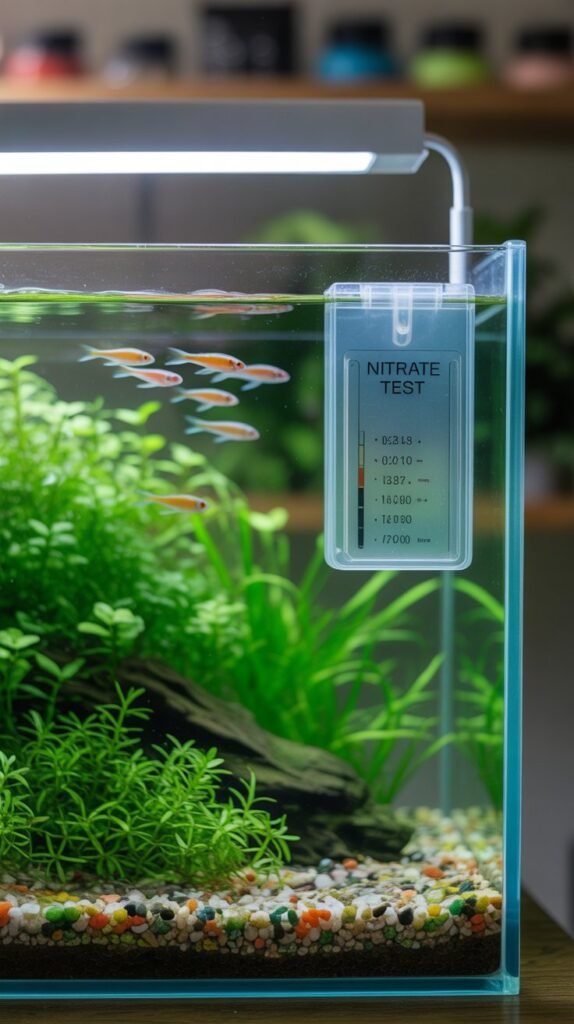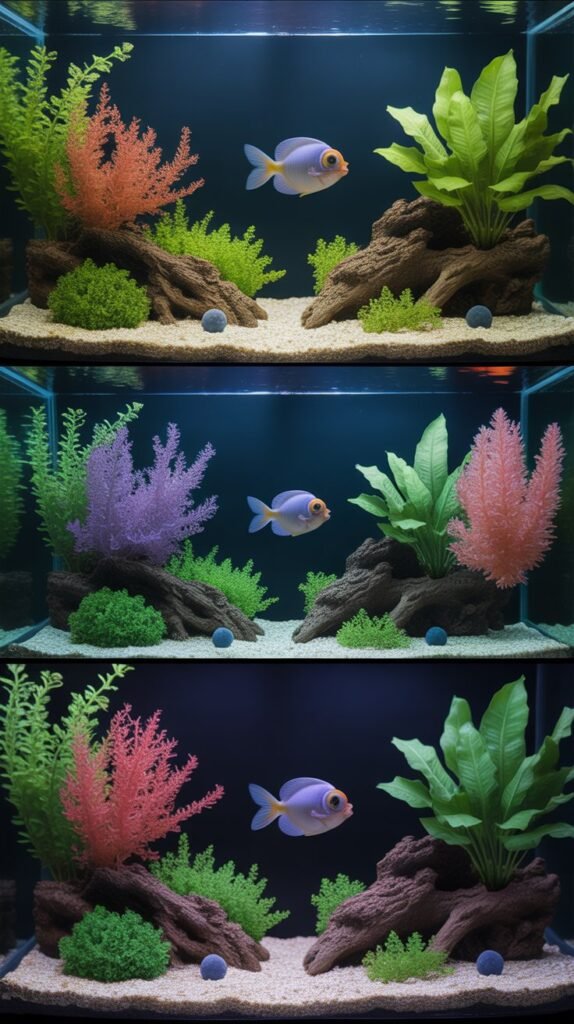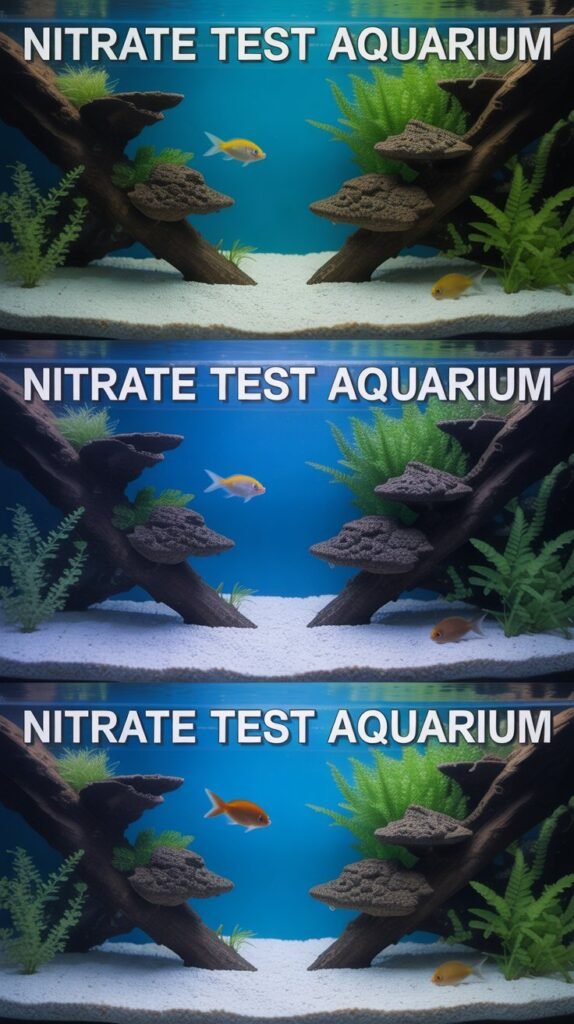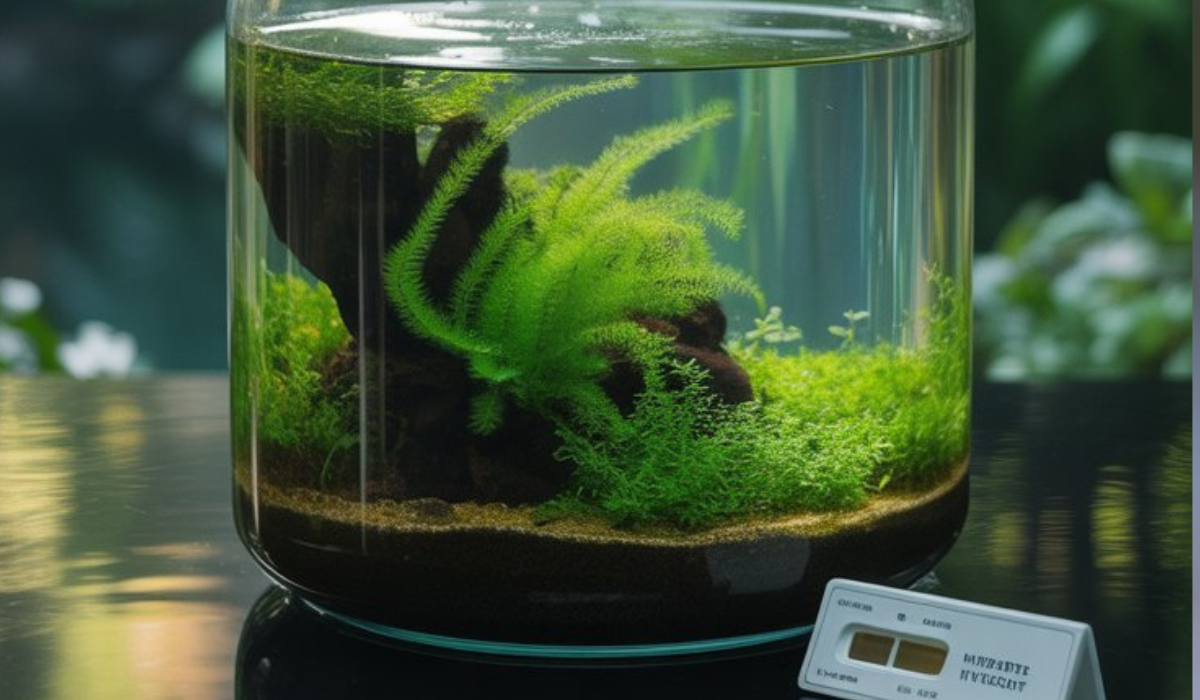Maintaining the perfect water quality is one of the most important aspects of aquarium care, and one of the key parameters to monitor is nitrate (NO₃⁻). High nitrate levels can cause stress, poor coloration, stunted growth, and even death in fish and invertebrates. That’s why understanding how to perform a nitrate test in your aquarium and interpret the results is essential for every aquarist.
In this comprehensive 2500-word guide, we’ll explore everything you need to know about nitrate testing, including why it matters, how to test for it, the best kits available, and how to maintain safe nitrate levels in your aquarium.
What Are Nitrates in an Aquarium?
Nitrates (NO₃⁻) are a natural byproduct of the nitrogen cycle, a vital process in every aquarium. Here’s how it works:
- Fish waste, uneaten food, and decaying plant matter produce ammonia (NH₃).
- Beneficial bacteria convert ammonia into nitrite (NO₂⁻).
- A second group of bacteria then converts nitrite into nitrate (NO₃⁻).
While ammonia and nitrite are highly toxic to fish, nitrate is less harmful. However, high levels can still cause problems if not managed properly.
Why Testing Nitrates Is Important

Even though nitrates are less toxic, their accumulation can lead to multiple issues:
- Fish Stress: Elevated nitrate levels can cause stress and make fish more prone to disease.
- Algae Growth: Excess nitrates fuel unwanted algae blooms that make your tank look dirty.
- Poor Reproduction: Breeding fish are particularly sensitive to nitrate toxicity.
- Invertebrate Sensitivity: Shrimp and snails can die from prolonged exposure to high nitrate levels.
- Plant Health: While plants need nitrates, too much can cause imbalanced growth.
Regular nitrate testing ensures your tank remains a safe and healthy environment for all aquatic life.
Ideal Nitrate Levels in Aquariums
The acceptable nitrate range varies depending on the type of aquarium:
| Aquarium Type | Ideal Nitrate Range (ppm) | Notes |
|---|---|---|
| Freshwater Community | 0–40 ppm | Below 20 ppm is ideal for long-term health. |
| Planted Tank | 5–20 ppm | Plants use nitrate as fertilizer. |
| Saltwater Fish-Only | 0–30 ppm | Marine fish can tolerate slightly higher levels. |
| Reef Tank (Corals/Invertebrates) | 0–5 ppm | Corals are sensitive to high nitrate. |
| Shrimp Tank | 0–10 ppm | Shrimp are highly sensitive; keep levels low. |
Testing regularly helps maintain these ranges for optimal aquatic life health.
Types of Nitrate Test Kits for Aquariums
There are several types of nitrate test kits available, each with different levels of accuracy and ease of use.
1. Liquid Test Kits
Liquid kits are the most common and affordable. You mix water samples with reagents and compare the resulting color to a chart.
- Pros: Accurate and inexpensive
- Cons: Requires careful measurement and interpretation
- Popular Brands: API, Salifert, Seachem, Red Sea
2. Test Strips
These are paper strips dipped into aquarium water. They change color to indicate nitrate levels.
- Pros: Fast and easy to use
- Cons: Less accurate, affected by lighting and user interpretation
- Popular Brands: Tetra EasyStrips, JBL, Aqueon
3. Digital Testers
Digital nitrate meters provide precise readings and are ideal for advanced hobbyists.
- Pros: Highly accurate and easy to read
- Cons: Expensive and require calibration
- Popular Models: Hanna Checker, Seneye, Neptune Apex Trident
How to Perform a Nitrate Test in an Aquarium

Testing nitrates is simple if you follow the correct steps. Here’s a step-by-step guide using a liquid nitrate test kit (e.g., API):
Step 1: Prepare the Test Tube
Take the provided test tube and rinse it with aquarium water to prevent contamination.
Step 2: Collect the Water Sample
Fill the tube with aquarium water up to the marked line (usually 5 ml).
Step 3: Add Test Reagents
Add the recommended number of drops from the reagent bottles:
- For API kits, add 10 drops of Bottle #1 and shake the Bottle #2 for 30 seconds before adding 10 drops.
- Shake the test tube for 1 minute to mix thoroughly.
Step 4: Wait for the Reaction
Let the test sit for 5 minutes. The color will gradually change based on nitrate concentration.
Step 5: Compare the Color
Match the tube’s color to the chart provided with your kit to determine the nitrate level in ppm (parts per million).
Step 6: Record the Result
Write down the date and result in a testing log. Keeping track helps you identify long-term trends.
How Often Should You Test for Nitrates?
The frequency of testing depends on your aquarium type and maintenance schedule:
| Aquarium Type | Testing Frequency |
|---|---|
| New Tank (Cycling) | Every 2–3 days |
| Established Freshwater | Once per week |
| Reef Tank | 2–3 times per week |
| High Bioload Tanks | Twice per week |
| Low Bioload/Planted Tanks | Once every 2 weeks |
Consistency is key — regular monitoring prevents harmful spikes.
Causes of High Nitrate Levels
If your test shows high nitrates, it’s essential to understand the root cause. Common reasons include:
- Overfeeding: Uneaten food decomposes, releasing nitrogen compounds.
- Overstocking: Too many fish produce excessive waste.
- Infrequent Water Changes: Nitrates accumulate over time.
- Dirty Filters: Clogged filters become nitrate traps.
- Poor Plant Growth: Lack of live plants to absorb nitrates.
- Tap Water Contamination: Some tap water contains nitrates before entering the aquarium.
How to Lower Nitrate Levels
If your test reveals high nitrate levels, act quickly to reduce them:
1. Perform Regular Water Changes
Replace 20–50% of your aquarium water weekly. Use dechlorinated water to avoid harming fish.
2. Clean the Substrate and Filter
Remove detritus and debris where nitrate-producing bacteria thrive.
3. Add Live Plants
Fast-growing plants like hornwort, anacharis, and water sprite absorb nitrates efficiently.
4. Reduce Feeding
Feed only what fish can consume in 2–3 minutes, once or twice daily.
5. Use Nitrate-Removing Media
Filter media like Seachem De*Nitrate, Purigen, or API Nitra-Zorb help lower nitrates naturally.
6. Install a Refugium (for Marine Tanks)
A refugium with macroalgae like chaetomorpha helps absorb excess nutrients.
7. Test Tap Water
If your tap water contains nitrates, use RO (Reverse Osmosis) or RODI water instead.
How to Maintain Stable Nitrate Levels

Preventing nitrate buildup is easier than constant correction. Follow these maintenance tips:
- Perform consistent water changes.
- Use a quality biological filter.
- Avoid overstocking the tank.
- Feed sparingly and remove uneaten food.
- Incorporate live plants or refugium systems.
- Monitor nitrates weekly and adjust routines as needed.
By maintaining these habits, your aquarium will stay balanced, clear, and healthy.
Best Nitrate Test Kits for Aquariums (2025 Guide)
Here are some top-rated nitrate test kits you can use for accurate readings:
- API Freshwater Master Test Kit
- Measures ammonia, nitrite, nitrate, and pH.
- Affordable and reliable for beginners.
- Salifert Nitrate (NO3) Profi-Test
- Excellent for reef tanks and marine aquariums.
- Provides high accuracy at low nitrate levels.
- Hanna Marine Nitrate Checker (HI781)
- Digital precision for reef hobbyists.
- Displays readings in ppm without color interpretation.
- Seachem MultiTest Nitrate
- Offers detailed testing and calibration.
- Suitable for both freshwater and saltwater systems.
- Tetra EasyStrips 6-in-1
- Quick and convenient for routine checks.
- Measures nitrate, nitrite, hardness, and more.
Common Mistakes When Testing for Nitrates
Many aquarists unknowingly make errors that lead to inaccurate readings:
- Not Shaking Reagent Bottles Properly: Some chemicals settle at the bottom.
- Using Dirty Test Tubes: Residue from previous tests affects results.
- Testing Immediately After Feeding: Food particles skew nitrate levels.
- Ignoring Expiration Dates: Old reagents produce unreliable readings.
- Not Following Wait Times: Color may not fully develop before reading.
Always follow instructions carefully to ensure accurate nitrate measurement.
The Relationship Between Nitrate, Ammonia, and Nitrite
Understanding how these three compounds interact is crucial:
- Ammonia (NH₃): Most toxic; produced from waste.
- Nitrite (NO₂⁻): Converted from ammonia by bacteria.
- Nitrate (NO₃⁻): Final product, less toxic but still harmful in excess.
Regular testing of all three ensures your biological filtration is functioning effectively.
Nitrate and Algae Growth
One of the most visible signs of high nitrate is excessive algae.
Green water, hair algae, and diatoms thrive in nitrate-rich environments.
To control algae:
- Maintain nitrate below 20 ppm.
- Balance lighting duration (6–8 hours daily).
- Add algae-eating fish or snails.
- Use phosphate removers to limit nutrient availability.
Nitrate in Planted Aquariums
Unlike fish-only tanks, planted aquariums benefit from moderate nitrate levels. Plants use nitrate as a nitrogen source for growth.
However, imbalance can occur if nitrate levels drop too low, leading to:
- Yellowing leaves (nitrogen deficiency)
- Stunted growth
- Algae outcompeting plants
Ideal range for planted tanks: 5–20 ppm.
Fertilizers like Seachem Nitrogen or Aquarium Co-Op Easy Green help maintain proper levels.
Advanced Methods of Nitrate Control
For large or sensitive aquariums, advanced nitrate control systems can be beneficial:
1. Nitrate Reactors
These specialized filters use anaerobic bacteria to convert nitrate into nitrogen gas, removing it from the system.
2. Deep Sand Beds
Used in marine tanks; promote anaerobic zones for nitrate breakdown.
3. Bio-Pellet Reactors
Feed carbon to beneficial bacteria that consume nitrate efficiently.
4. Denitrifying Media
Products like Matrix or Biohome Ultimate offer porous surfaces for nitrate-reducing bacteria.
Signs of High Nitrate Levels in Fish
Even without testing, you can sometimes spot warning signs of nitrate stress:
- Lethargic or gasping fish
- Loss of appetite
- Faded coloration
- Clamped fins
- Increased algae growth
- Poor breeding performance
If these symptoms appear, test immediately and perform a water change.
Conclusion
Testing nitrates in your aquarium is not just about numbers — it’s about ensuring the long-term health of your fish, plants, and corals.
With regular nitrate testing, consistent maintenance, and the right filtration, you can prevent water quality issues before they harm your aquatic life.
Whether you’re maintaining a planted freshwater tank or a delicate coral reef, nitrate testing is a simple habit that guarantees a thriving, beautiful aquarium.
FAQs About Nitrate Test Aquarium
Q1: How often should I test nitrates in my aquarium?
Test weekly for freshwater tanks and 2–3 times a week for reef tanks, especially if your tank has a high bioload.
Q2: What is the safe nitrate level for fish?
Ideally below 20 ppm for most freshwater fish. Reef and shrimp tanks should stay under 10 ppm.
Q3: My nitrate test always shows high results. What should I do?
Reduce feeding, increase water changes, clean filters, and add live plants or nitrate-removing media.
Q4: Can I use tap water for aquarium water changes?
Yes, but test it first. Some tap water contains nitrates; if so, consider using RO or distilled water.
Q5: Are nitrate test strips accurate?
They provide a quick estimate but are less precise than liquid or digital test kits.
Q6: Why do plants need nitrates?
Nitrate is an essential nitrogen source for plant growth and helps develop lush, green leaves.
Q7: Can high nitrates kill fish?
Yes, prolonged exposure to high nitrates causes stress, weakens the immune system, and may lead to death.
Q8: What’s the best nitrate test kit for beginners?
The API Freshwater Master Test Kit is affordable, reliable, and easy for beginners to use.
Q9: Can algae growth indicate high nitrate levels?
Absolutely. Algae thrive on nitrates; persistent algae growth often means nitrate buildup.
Q10: How can I naturally lower nitrates?
Regular water changes, live plants, reduced feeding, and maintaining a clean substrate are the most effective natural methods.

